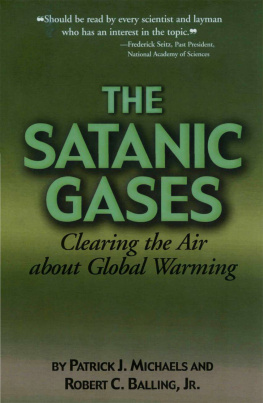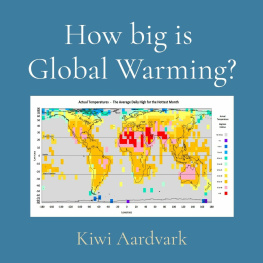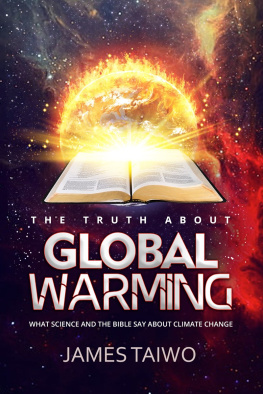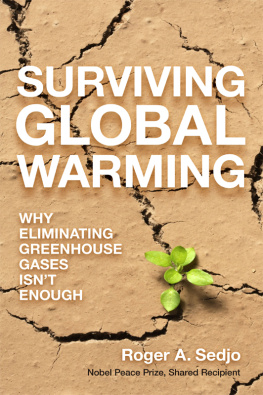THE
SATANIC
GASES
THE
SATANIC
GASES
Clearing the Air about Global Warming
BY P ATRICK J. M ICHAELS AND R OBERT C. B ALLING, J R.
INSTITUTE
Washington, D.C.
Copyright 2000 by the Cato Institute.
All rights reserved.
Second Printing: September 2000
Third Printing: February 2001
Fourth Printing: July 2002
Fifth Printing: October 2005
Library of Congress Cataloging-in-Publication Data
Michaels, Patrick J.
The satanic gases : clearing the air about global warming / by Patrick J. Michaels and Robert C. Balling, Jr.
p. cm.
Includes bibliographical references and index.
ISBN 1-882577-91-4.ISBN 1-882577-92-2
1. Global warming. I. Balling, Robert C. II. Title
QC981.8.G56 .M537 2000
Printed in the United States of America.
C ATO I NSTITUTE
1000 Massachusetts Ave., N.W.
Washington, D.C. 20001
Acknowledgments
As first author, I had the opportunity to write this book because of a half-time appointment as senior fellow in environmental studies at Cato Institute. It is a remarkable place to work, as the Institute's influence is far out of proportion to its modest budget. Cato owes its success, and lowe this book, to Ed Crane, who runs the Institute.
Actually, he does not "run" it. Cato runs itself. Ed's genius is that he knows that the people he hires will not have to be told what to do, which is why Cato is so efficient. Cato also has a lovely building and, for folks who do not spend a lot of time in church, the classiest Christmas decorations in Washington. I could not imagine that working for someone else could be so much fun.
Jerry Taylor, director of natural resource studies at Cato, was responsible for bringing me to the Institute, and he has labored for days and nights over the various versions of this manuscript. I have been around environmental issues for decades and have never found anyone as well read as Jerry in the related science, economics, and policy. If I need to steal some weighty tome on these matters, I sneak up to his office. He has so many books along these lines that he has yet to notice the attrition. This book has benefited immeasurably from his efforts and his commitment to understanding the environmental issues we all confront.
James Ruin Lawrence, an intern at Cato, provided invaluable technical assistance. He is now completing his studies in Physics and Philosophy at Washington University. Should he apply for a position with your company you will do very well to hire him.
I also owe much of this book to the people at New Hope Environ mental Services, a little company I started six years ago in New Hope, Virginia, dedicated to getting the facts out on a number of environmental issues, including global warming. New Hope also employs second author Bob Balling, of Arizona State University. The University of Virginia's Bob Davis, who wrote the initial text (since modified by the authors) for some of the sections on nor'easter storms and weather-related mortality, is another New Hoper. The same is true of for Arizona State University's Keith Idso, who wrote some of the original text on planetary greening, and Stanford University's Thomas Gale Moore, who contributed the material for a portion of the section on human health. For a much more in-depth look at that issue, consult Moore's fine book Climate of Fear, which Cato published in 1998.
The best New Hoper of them all is Paul C. ("Chip") Knappenberger, who did most of the technical analyses and graphics that went into this book. Chip is an encyclopedia of climate data and the best employee I have ever had. Amy Lemley, New Hope's editor extraordinaire (and maybe the best writer in Charlottesville), spruced up much of the text. Among other books, Amy is coauthor of Beyond Shyness, the title of which reflects the tone of this manuscript.
Considerable support for the quantitative analyses that went into this book came from the Greening Earth Society, of Arlington, Virginia. That membership organization was started by Frederick Palmer, CEO of Western Fuels Association, a not-for-profit energy cooperative. Without Fred, I truly believe the onerous Kyoto Protocol on global warming-or something like it-would be the law of this land today. The environmental community apparently agrees, too, judging from the number of television documentaries and newspaper features explaining that the only reason Americans have not cheerfully committed economic suicide to stop global warming is a pernicious industry campaign organized by Fred. Never mind that Washington spends at least 10,000 times as much as industry to promote its view of climate change, a tribute to federal efficiency.
Greening Earth Society also supports the biweekly World Climate Report, the sassiest, hippest, nastiest, and best online newsletter in history on global climate. I edit the thing. It is available at www.greeningearthsociety.org. The WCR staff accomplishes at least two tasks-writing and communicating science-much better than the feds, and the newsletter therefore drives them to apoplexy and even worse writing. Perceptive readers will see that small portions of the text in this book look a lot like WCR.
Thanks also to the University of Virginia for allowing the release time for me to pursue this project. It is easy to gripe about political correctness and the leftward bias of the academy, about which there is little doubt, but it is also true that UV A has never impeded my freedom of expression and in fact has provided considerable internal funds toward getting my peculiar message out. It has not hurt that most of the climatologists at UV A are pretty much in agreement as to the nature of the global warming issue, and that Thomas Jefferson, whose presence still lives there (a friend said he saw him just the other day at the 7-Eleven!), fancied himself a climatologist too.
The cliche about thanks to my family for all the sacrifice while I put this manuscript together is more than true. Little can make one crabbier than writing a book, and many, many nights in Washington created this one, providing far too little attention to QTI1, Bobbo, and Erika. You know who you are and why you are so special to me. It is my privilege to know that, too. Raoul the Siamese Weather Cat died for this book.
PJM
New Hope, Virginia
December 1999
Preface
In 1991 Patrick Michaels wrote Sound and Fury: The Science and Politics of Global Warming, and Robert Balling wrote The Heated Debate-both in response to the developing distortion of scientific reality by the political process and the media that cover it. Since then, that distortion has waxed and waned, always seeming to reach a crescendo prior to some important meeting, such as the December 1997 UN Conference in Kyoto, immediately before which ensued an onslaught of one-sided reporting. Because global warming and the Kyoto Protocol are likely to be important subjects in the 2000 election, now is an appropriate juncture at which to investigate the scientific developments that have emerged in the eight years between manuscripts.
Sound and Fury concluded with brief forecasts for the future-all of which, right or wrong, are encapsulated here. First, those that proved correct:
"The Temperature Record Will Warm .... We can, at least in the near term, expect to see news stories every January about how the preceding year was the warmest, or nearly the warmest, year in the past century."










